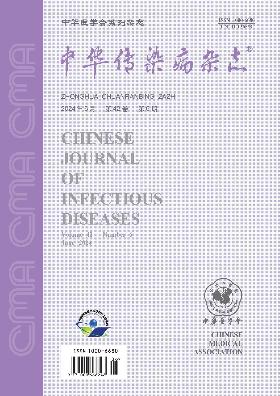大剂量卡泊芬净治疗侵袭性肺曲霉病的疗效和安全性
引用次数: 0
摘要
目的探讨大剂量卡泊芬净(70mg /d)作为侵袭性肺曲霉病初始或挽救治疗的临床疗效和安全性。方法回顾性分析2014年6月至2017年10月复旦大学华山医院确诊或疑似侵袭性肺曲霉病患者21例。根据大剂量卡泊芬净应用前的抗真菌治疗情况,将患者分为初始治疗组和抢救治疗组。收集患者的临床资料和实验室资料。观察两组患者的特点、临床疗效、不良反应、1年生存率及总有效率。采用Kaplan-Meier分析比较两组患者的预后。结果21例患者中有20例在治疗基础疾病过程中发生机会性获得性侵袭性肺曲霉病。5例患者最初使用高剂量caspofungin治疗68(62)天。第12周,1例患者完全缓解,3例患者部分缓解,总有效率为80%(4/5)。16例患者接受caspofungin补救性治疗66.50(58)天,其中第12周完全缓解1例,部分缓解10例,总有效率为68.75%(11/16)。1年随访显示,初始治疗组无患者死亡,1年生存率为100%(5/5)。抢救治疗组3例患者死于肺部细菌感染,1年生存率为81.25%(13/16)。在治疗期间,一名患者总胆红素升高,这可能与高剂量卡泊芬金有关。结论大剂量卡泊芬净方案对侵袭性肺曲霉病的初始治疗和抢救治疗均具有良好的疗效和安全性。关键词:侵袭性肺曲霉病;Caspofungin;大剂量;功效;安全本文章由计算机程序翻译,如有差异,请以英文原文为准。
Efficacy and safety of high-dose caspofungin in the treatment of invasive pulmonary aspergillosis
Objective
To investigate the clinical efficacy and safety of high-dose caspofungin (70 mg/d) as initial or salvage treatment for invasive pulmonary aspergillosis.
Methods
Twenty-one patients with proven or probable invasive pulmonary aspergillosis from June 2014 to October 2017 in Huashan Hospital, Fudan University were retrospectively reviewed. According to the anti-fungal treatment before high-dose caspofungin application, patients were divided into initial treatment group and salvage treatment group. Patients′ clinical data and laboratory data were collected. The characteristics, clinical efficacy, adverse reactions, one-year survival rate and the overall effective rate were evaluated. The prognosis of the two groups was compared by Kaplan-Meier analysis.
Results
Twenty of the 21 patients opportunistic acquired invasive pulmonary aspergillosis during the treatment of underlying diseases. Five patients were initially treated with high-dose caspofungin for 68 (62) days. At week 12, one patient achieved complete response, 3 patients achieved partial response, and the overall effective rate was 80%(4/5). Sixteen patients received caspofungin as salvage therapy for 66.50 (58) days, of which one patient got complete response at week 12, 10 had partial response, and the overall effective rate was 68.75%(11/16). One-year follow-up showed that no patient died in the initial treatment group, and the one-year survival rate was 100%(5/5). In salvage treatment group, 3 patients died of pulmonary bacterial infections and the one-year survival rate was 81.25%(13/16). During treatment, one patient had elevated total bilirubin, which was possibly associated with high-dose caspofungin.
Conclusions
High-dose caspofungin regimen has good efficacy and safety, both for initial treatment and salvage therapy in patients with invasive pulmonary aspergillosis.
Key words:
Invasive pulmonary aspergillosis; Caspofungin; High-dose; Efficacy; Safety
求助全文
通过发布文献求助,成功后即可免费获取论文全文。
去求助
来源期刊
自引率
0.00%
发文量
5280
期刊介绍:
The Chinese Journal of Infectious Diseases was founded in February 1983. It is an academic journal on infectious diseases supervised by the China Association for Science and Technology, sponsored by the Chinese Medical Association, and hosted by the Shanghai Medical Association. The journal targets infectious disease physicians as its main readers, taking into account physicians of other interdisciplinary disciplines, and timely reports on leading scientific research results and clinical diagnosis and treatment experience in the field of infectious diseases, as well as basic theoretical research that has a guiding role in the clinical practice of infectious diseases and is closely integrated with the actual clinical practice of infectious diseases. Columns include reviews (including editor-in-chief reviews), expert lectures, consensus and guidelines (including interpretations), monographs, short monographs, academic debates, epidemic news, international dynamics, case reports, reviews, lectures, meeting minutes, etc.

 求助内容:
求助内容: 应助结果提醒方式:
应助结果提醒方式:


